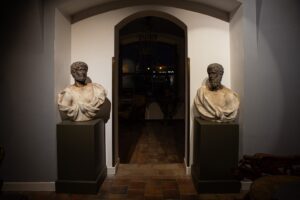Pair of Imperial Busts: Hadrian and Marcus Aurelius
European Schools, 17th–19th Century
Composite works in bronze and marble
This striking pair of busts represents two of Rome’s most revered philosopher-emperors: Hadrian (76–138 AD) and Marcus Aurelius (121–180 AD). Executed between the 17th and 19th centuries, they exemplify the enduring admiration for classical antiquity in European art.
📌 Description
-
Hadrian:
– Bronze head (19th century) mounted on a marble torso and toga (18th century)
– Expressive bronze detailing: structured curls, short beard, and a contemplative expression
– The marble toga is carved in deep imperial folds, softened by 18th-century Neoclassical style
-
Marcus Aurelius:
– Modeled in bronze (head) with a marble torso and toga
– Characteristic curly hair and beard, deep-set eyes, and high forehead, evoking the Stoic philosopher
– Drapery reflects Roman classicism interpreted through a Baroque–Neoclassical lens
🏛️ Historical Significance
Hadrian and Marcus Aurelius were both military leaders and intellectuals, associated with Stoicism, Greek philosophy, and cultural patronage.
These busts reflect the taste of Grand Tour collectors, and were likely produced for aristocratic or scholarly interiors, blending historical reverence with contemporary artistic ideals.
Dimensions (approximate):
– Hadrian: H. approx. 60–65 cm
– Marcus Aurelius: H. approx. 60–65 cm
Condition: Some wear and minor restorations
